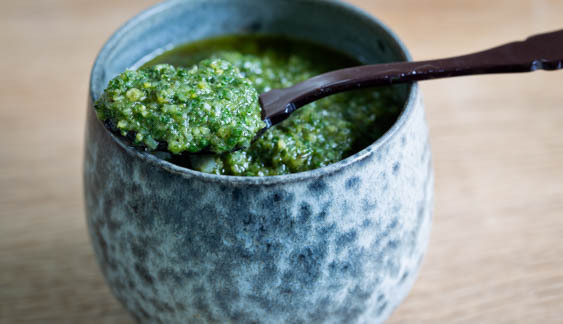Pesto alla Genovese

introduction
Properly speaking, pesto refers to a class of sauce rather than an actual recipe. Herbs, nuts, garlic, cheese, olive oil—each ingredient is raw, and the sauce uncooked. The word itself, “pesto,” comes from the Italian pestare, meaning to pound or crush, which is exactly how pesto has been prepared since first recorded in Italy in the 1860s—pounded and crushed in a mortar and pestle. More recently, pesto’s popularity has produced ingredient combinations that confound the imagination and palate—herbs ranging from mint to cilantro and nuts ranging from cashews to hazelnuts. We challenge any of these combinations to produce one-tenth the magic of traditional pesto alla genovese, a terroir-driven regional sauce whose ingredients don’t stray far from the Ligurian countryside: fresh basil leaves harvested at the end of spring, pine nuts, extra-virgin olive oil, and grated aged cheese.
Cooking Remarks
Nobody wants to pound large quantities of pesto in a mortar these days. And we don’t all get to live on a hillside in Liguria. But we can take ownership of good ingredients and a process that will produce pesto alla genovese as close to the original as possible. Pesto is meant to be mossy, bright, flowing, fragrant, woodsy—in short, the enunciation of summer. Its flavor should be assertive, but soft and round, driven by buttery Ligurian olive oil; fresh basil (Genovese if you or grow it or your farmers market sells it), hardneck garlic, recently harvested—or at least good; pine nuts that bear no rancidity and have not been toasted; first-rate Parmesan Reggiano; and some Peccorino Sardo, a lightly smoked sheep’s milk cheese from Sardinia that adds trace acidity and real flavor depth. Each of these ingredients in the proper ratio will keep pesto from succumbing to stridency—and the most of the ingredients are easy to find . . . with just a bit of clicking.
Food processor? Sure. But don’t just throw everything in together and let it rip. Pesto should be creamy and slippery, yet still possess texture. It should not be homogenous or a paste. We recommend pulsing the ingredients and stirring in the cheese by hand at the end. Pesto will hold very well for a few days in the fridge if covered by ½ inch or so of olive oil and sealed with a lid.
equipment mise en place
For this recipe, you will need a digital kitchen scale, a food processor, a rubber spatula, a small bowl, and a glass jar with a tight lid for storage.
-
-
2ounces raw pine nuts
-
4 or 5small-medium garlic cloves (0.6 ounces), germ removed if present, finely chopped
-
1⅛teaspoons fine sea salt
-
1teaspoon freshly ground black pepper
-
2ounces fresh basil leaves
-
¾cup Ligurian extra-virgin olive oil, plus additional oil for storing
-
0.5ounce grated Pecorino Sardo
-
1ounce grated Parmesan Reggiano
-
-
In a food processor, combine the pine nuts, garlic, salt, and pepper. Pulse until the nuts are chopped, about 10 quick pulses. Add the basil and about 2 tablespoons of the olive oil and pulse a few times to chop the leaves. Scrape down the bowl with a rubber spatula. While pulsing, pour the remaining olive oil through the feed tube. Keep pulsing, until the mixture is creamy but still textured, about 6 quick pulses. Transfer to a small bowl, then stir in the cheeses by hand.
-
Transfer the pesto to a glass jar, cover with ½ inch of olive oil, and seal with tightly with a lid. Refrigerate for up to 3 days or so.